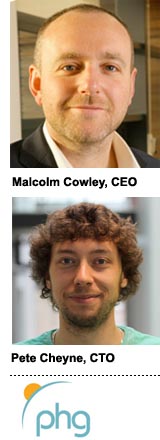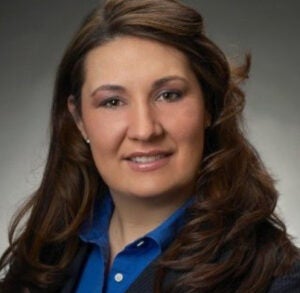 Performance Horizon Group (PHG) is an affiliate marketing campaign management provider whose clients have included Sony and T-Mobile. Started in 2010 with seven employees, the company now has nearly 60 on staff in offices in London and Newcastle, England, New York and Sydney.
Performance Horizon Group (PHG) is an affiliate marketing campaign management provider whose clients have included Sony and T-Mobile. Started in 2010 with seven employees, the company now has nearly 60 on staff in offices in London and Newcastle, England, New York and Sydney.
The company is led by some of the founding members of Buy.at, a British affiliate marketing network acquired for $125 million by AOL in 2008.
Recently, PHG introduced optimization tools for brands working with Apple’s iBeacon tracking feature for iOS. Using iBeacon, a retailer can, for example, track where a customer is in a store via their mobile device and offer relevant discounts.
Malcolm Cowley, PHG’s CEO, and Pete Cheyne, CTO, both co-founders of Buy.at, spoke with AdExchanger about the company and the affiliate marketing management space.
AdExchanger: What problem do you solve?
MALCOLM COWLEY: As a brand, you go sign up to the [affiliate and partner] networks and you know that you are then going to get access to distribution and you’re going to be using the unsophisticated tools that are available to track those relationships.
You’re pretty much going to have an incubator period where you learn about which partners drive volume. Then when you want to really scale up, you start looking for different tools that would allow you to understand the true value and then you scale from there.
That’s where Performance Horizon Group comes in. We are a technology provider and we provide an assessment application called ExactView, which allows those brands to work directly with the publishers and upscale globally. That’s kind of how we see our mission at the moment. This first phase of the company is about how we connect global enterprises directly to their publisher base and upscale.
What is your addressable market?
COWLEY: We’re talking about a $10 billion market. So that’s the opportunity that PHG really sees in front of it.
Let’s say that it is a finance company that wants to acquire credit card customers or a retailer that wants to sell products. If they are conducting ecommerce or m-commerce, then one of the channels that they’re going to utilize is an affiliate or partner marketing.
They’re paying (affiliates a) commission on a performance basis. That’s the market that we address.
What are the challenges there?
COWLEY: The challenge with that marketplace – and, certainly, as we saw from our Buy.at history – is that most of the activity is kind of early stage. So you market a brand and want to understand how that channel works. They’re looking for distribution. They joined an affiliate network, which is a great way to get quick distribution, and then they start to understand which publishers drive volume for them, but, at that stage, they might not necessarily really understand the value that’s driven by each publisher.
So time goes on and volumes increase and there are data increases, which is an issue across the board for digital advertising, and the next thing they know, the technology platforms that are in play start getting in the way of doing business. They find it harder and harder to execute the peer distribution play, but you also understand that data can really move the needle for you if you can get the data in real time and understand that data and take action on it. There’s this actionable insight that everyone talks about. Then they could have a far more profitable relationship with their publishers and partners.
What PHG is trying to do is it’s trying to solve that problem globally for the brand by providing one global platform, essentially. It’s one technology solution that brands would use globally to execute their strategies with these affiliate partnerships.
What about revenues and growth?
COWLEY: To give you an idea, we founded this business in 2010 and we had a minimum viable product out in 2011. It’s been around three years now and the business has grown at over 100%, in terms of year-on-year growth, since then. In this final year, in terms of quarter to quarter, like Q1 of 2014 vs. Q1 of 2013, was actually 300%. We’re really hitting that high-growth stage now.
As a business, we have (almost) 60 heads across our main regions which are the US, the UK and Australia. We’re supporting large enterprises, whether it’s in our regions or globally. We’re on for double digits this year.
What goals do you have for the future?
COWLEY: We’ve just been putting together our future plans and when you look at our forecasting over the next four years, including this year – so, to the end of 2017 – we have around 30 customers today and the plan is to take it to 400.
From a staff perspective, we’re just short of 60 at the moment. The plan there is to take our number to 270.
Who are your investors, and what funding plans do you have?
COWLEY: We have seed funding from a venture capital firm in Europe, DN Capital. We also have Series A funding from a US-based firm, Greycroft. Today, they’ve been our main backers. We’ve raised a couple of rounds.
We’re just kind of in that growth phase now, so funding is something that we want to think about.
How do we want to go and execute this vision? It’s a big vision. We’re talking about a business, from a forecast perspective, that is set for 100% or greater year-on-year growth for the next four years. That’s an IPO contender right there.
We certainly believe that that is a conservative forecast and it’s definitely tempting, as a business that’s already VC-funded, to think about how we can utilize extra funds to be able to execute this vision faster.
What are you doing with iBeacon?
PETE CHEYNE: (iBeacon) is an extension of the functionality of the location services on (iOS). It works through Bluetooth.
Now, what’s exciting to us and what’s relevant to us is that for years and years, advertisers have tried to close that loop between their advertising activities online and driving people offline into those stores. There have been various attempts, through the years, to use online tracking methods to understand how many people eventually convert, but convert offline.
That’s usually required a human element in order for it to be fed back into the online world. Of course, as soon as you introduce a human element, accuracy goes way down. So nothing has ever taken off and been a legitimate technology for closing the loophole between online to offline.
Why iBeacon?
CHEYNE: Where iBeacon comes in is that it finally is, we believe, a legitimate technology that will allow for an accurate portrayal of conversion activity that happens from online to offline. What we’ve done is simply integrated that technology into our tracking API which will allow our clients to understand exactly what’s happening when there’s this footfall that’s being driven from an intent to purchase from online and then they’re actually transacting offline.
So, in a nutshell, that’s what we’ve done. We’ve integrated this technology and it’s now going to open up some quite interesting new cases to advertisers and publishers on that platform.
Such as?
CHEYNE: We have a couple of examples of how we see this working. The first is purely for advertisers themselves who want to understand, the activity that they’re driving and what’s happening offline. If you imagine that an advertiser places a few beacons around their store, what this allows them to track through that technology through anyone who has an iBeacon-enabled app.
For example, in this case, an advertiser might have a loyalty app which they’ve used previously to offer some coupons to their loyal customers that say, “Next time you’re in the store, here’s a code for 10% off.” Before iBeacon was there and before the companies like ourselves were able to track that, we didn’t really have any understanding of how many people redeemed that deal.
Now you could say, “If they’ve been in a specific area for more than two minutes, I will fire a notification through to the app that will give them a specific deal for the clothing department.” You could also file specific tracking events through to the API that would be telling you to rate the publisher for that activity.
The sky is the limit and we won’t limit what types of conversion or events would be relevant to an advertiser. It’s completely up to them. We offer a generic tracking platform and then it’s just about how imaginative the advertisers can be, in terms of what we want to track through the platform.













